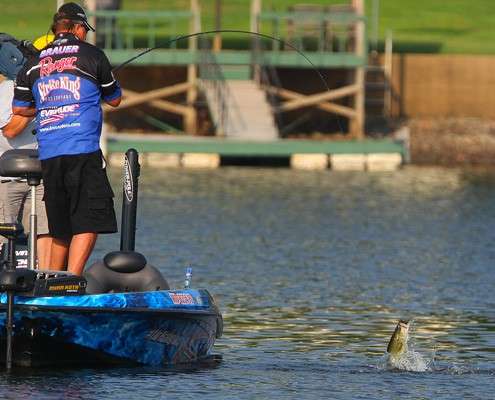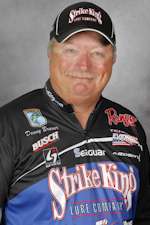
Once the days start to shorten and the waters start to cool, you have two basic options if you want to catch bass: Fish the flat side of the lake or fish the backs of the coves and the creeks.
If you're on the flat side of the lake, you should be looking for isolated pieces of cover. A stump sitting all by itself on an open flat is a perfect place for a bass to set up a feeding station. The baitfish will be drawn to that stump and will make an easy meal for the bass.
That doesn't mean, however, that the stump must be large or imposing. Get that idea out of your head. A tiny stickup — maybe no more than a quarter of an inch in diameter — is often all it takes to make a feeding spot. For a bass, this time of the year is about eating in anticipation of the coming winter. Nothing else matters.
The backs of the coves and creeks are somewhat different. Often heavy cover is the key to a good bite, and for some reason the bass that migrate into these areas are late-day feeders. By that I mean that the bite is almost always better in the afternoon and evening in these places than it is in the early morning. I'm not sure why, but I've found that to be true everywhere I've fished around the country.
I've often wondered if it has something to do with the plankton and the algae. Maybe it grows or blows into the shallows with the sun and that draws the baitfish into the area. Or it could be that the water is warmer later in the day and that activates everything. Or it could be something we can't even imagine, like the bass migrating out at night and back in during the day.
In the end, the reason for this doesn't matter much to us as anglers. As long as we know where the fish are and when to fish for them, we can catch them if we use the right bait. Why is something to talk about later — like when we're bragging about our great catch over supper at the lodge.
My personal fishing preference is the flat side of the lake. The fish there will bite several Strike King baits. Our Pure Poison swim jig, our top-of-the-line spinnerbaits or our 1.5 and 2.5 square-bill crankbaits are all effective in the fall. I love to pitch one of these baits to isolated pieces of cover and pull them around likely looking spots. It's one of my favorite ways to fish.
But let's not kid ourselves. A jig can be a tremendous flipping or pitching option at this time of the year, too. Normally, I'll lighten up in fall with a 3/8-ounce model. I don't know exactly why, but the slightly smaller bait seems to catch more fish.
At the same time, however, I'm still going with action trailers. I like the Rage Tail Chunk because it has the movement I need to get the bites I want. Another trailer that is just as effective, if not more so, is the Rage Tail Hawg. It's a big, plastic creature bait that fall bass can't resist. It's absolutely one of the most effective fall bass lures I've ever fished with, and I've fished with a lot of them over the years.
Color choice is critical in the fall. My lure colors depend upon the water colors. If the water is dark, I like Texas craw for my jig and black neon for my trailer. If the water's a little clearer — common in many places in the fall — I'll switch my jig to green pumpkin craw and my trailer to watermelon red or green pumpkin.
One final thought: Not all bass move at the same time. Sometimes they seem to move in waves, sometimes as singles. Either way, if you find a good spot, it's likely to be good for a while in September and on into the middle of October. Fish it until it stops producing.
Originally published September 2010





